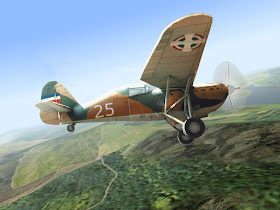Caza yugoslavo Ikarus IK-2
El Ikarus
IK-2 era un caza monoplano de ala alta y de construcción totalmente metálica de
diseño privado yugoslavo (Kosta Sivčev y Ljubomir Ilić). El prototipo fue
designado como IK-L1 y apareció en 1934, siendo sometido a pruebas al año
siguiente con el capitán Leonid Bajdak a los mandos. El
primer vuelo tuvo lugar el 22 de abril de 1935, sin embargo durante
estas primeras pruebas el motor falló y el aparato terminó por estrellarse
contra el suelo. Bajdak tuvo el tiempo suficiente para saltar salvando así la
vida en este accidente manifestando que el IK-1 no era apto para las labores de
un caza. Las investigaciones posteriores desvelaron que el accidente fue por
causa de una negligencia de los materiales de construcción del recubrimiento de
las alas.
El
siguiente prototipo fue designado como IK-2 era también de construcción
metálica y disponía de un radiador de enfriamiento superficial. El IK-2 estuvo
listo para las pruebas el junio de 1936 siendo el piloto Dobnikar quién lo puso
a prueba en esta ocasión. Durante estas pruebas se simuló un combate contra un
biplano Hawker Fury con Bajdak a los mandos. El IK-2 se mostró superior en
todos los aspectos al biplano inglés. Con estos resultados la Real Fuerza Aérea
yugoslava ordenó un pedido inicial de 12 cazas IK-2 que fueron entregados en
1937.
Cuando
se produjo la invasión alemana el 6 de abril de 1941, los IK-2 tomaron parte en
los combates aéreos desarrollados sobre Yugoslavia. Poco después los aparatos
supervivientes fueron utilizados para hostigar las columnas alemanas y en busca
de aparatos de reconocimiento alemanes. Tras la breve campaña en Yugoslavia tan
solo 4 IK-2 lograron sobrevivir y fueron reacondicionados en la fábrica de
Ikarus en Zemun antes de ser trasladados por los alemanes a la Fuerza Aérea del
recién formado Estado Independiente de Croacia.
Fuentes:
SHORES, C. “Air War for Yugoslavia, Greece & Crete – 1940-41” Grub Street, 1987
ORMEÑO,
J. “Messerschmitt Bf 109. El cazador de
la Luftwaffe”
MASON, “The Hawker Hurricane: An Illustrated History”
Crecy Publishing, 2002
English
version
The Ikarus IK-2 was a high-wing monoplane
fighter of all-metal construction
and design Yugoslav
private (Ljubomir Ilić and Kosta Sivčev). The prototype was designated as IK-L1
and appeared in 1934, being tested next year in
Leonid Bajdak captain
at the controls. The first flight took place on April 22, 1935, but during these first
tests the engine failed and
the machine ended up crashing into the ground. Bajdak had enough time to jump
thus saving the lives in this accident
stating that the IK-1 was not fit for the work of a fighter. Subsequent investigations revealed that the accident was caused by negligence of the construction materials of the lining of the wings.
The next prototype was designated as IK-2 was also of metal construction and had a surface cooling radiator. The IK-2 was ready for the June 1936 test pilot being Dobnikar who tested him on this occasion. During these tests simulated a battle against a Hawker Fury biplane with Bajdak at the controls. The IK-2 was superior in all respects to the English biplane. With these results the Yugoslav Royal Air Force ordered an initial order of 12 IK-2 fighters that were delivered in 1937.
At the time of the German invasion on April 6, 1941, the IK-2 took part in aerial combat over Yugoslavia developed. Shortly after surviving devices were used to harass the German columns and looking for German reconnaissance aircraft. After the brief campaign in Yugoslavia only 4 IK-2 survived and were overhauled in the Ikarus factory in Zemun before being taken by the Germans to the newly formed Air Force Independent State of Croatia.
Sources:
SHORES, C. “Air War for Yugoslavia, Greece & Crete – 1940-41” Grub Street, 1987
ORMEÑO,
J. “Messerschmitt Bf 109. El cazador de
la Luftwaffe”
MASON, “The Hawker Hurricane: An Illustrated History”
Crecy Publishing, 2002




No hay comentarios:
Publicar un comentario